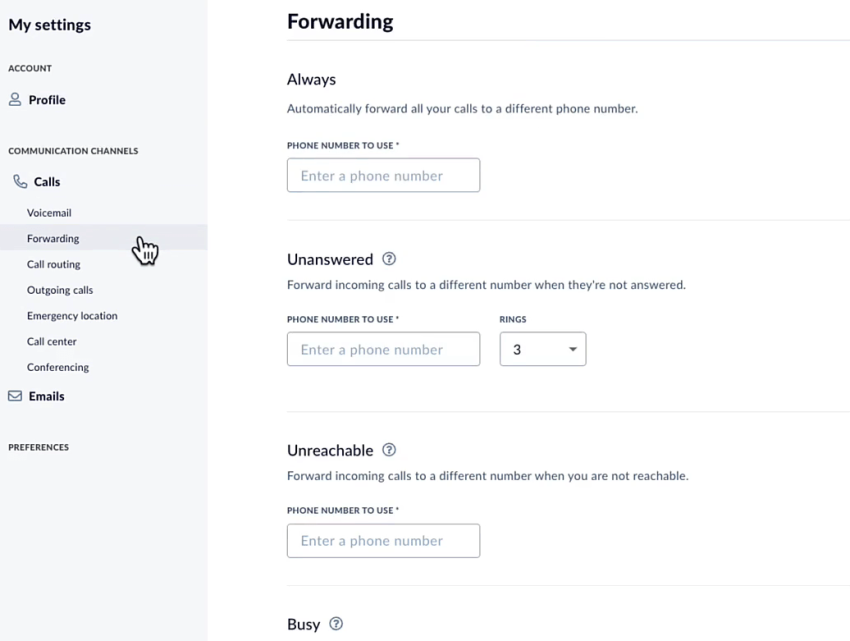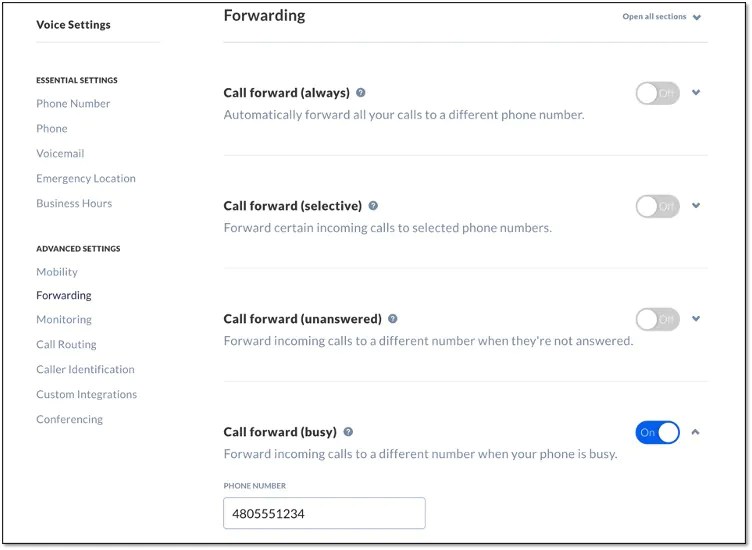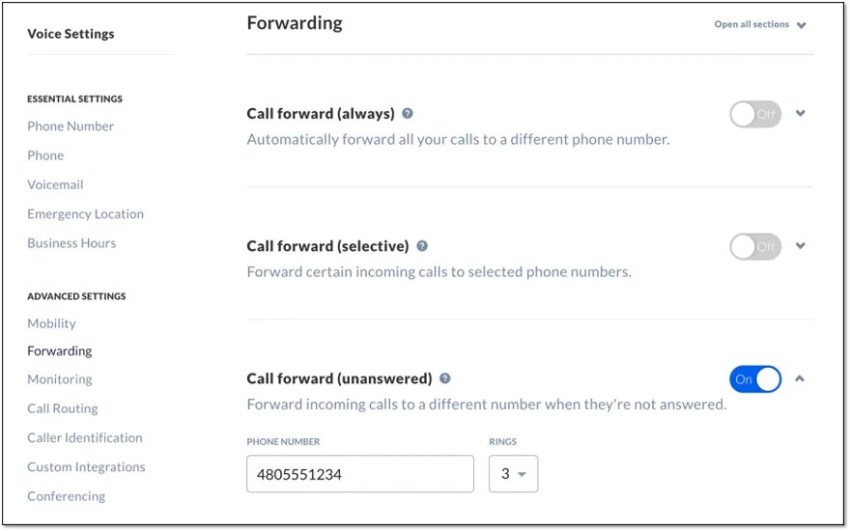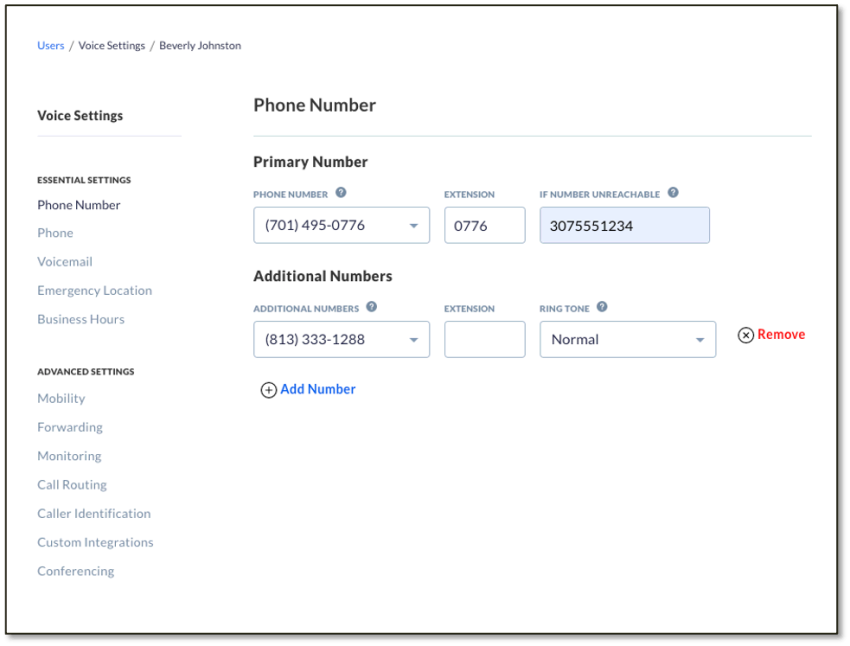Call forwarding isn’t just a convenience — it’s a powerful tool for businesses to seize opportunities the moment a call rings your business line.
Imagine you’re a traveling salesperson, constantly on the go and meeting clients. A potential deal could hang in the balance depending on your responsiveness.
But what happens when a crucial call comes into your office number while you’re out and about? Letting it go to voicemail, dropping the call, or having customers endlessly listen to hold music can damage your rapport with the client. This is where call forwarding features come in as lifesavers.
Call forwarding ensures every incoming call reaches you (or a team member) regardless of location. Whether you’re in a car, a coffee shop, or anywhere with a connection, you can maintain a professional presence and answer business calls with ease.

What Is Business Call Forwarding?
Call forwarding is a business phone system feature that routes incoming calls to a designated destination, like another phone number, mobile app, or voicemail system. This flexibility enables businesses to maintain continuity and avoid missing important customer calls, even when an employee is unavailable or away from their desk phone.
Multiple call forwarding rules work together to create a sophisticated call routing system that defines specific actions for different scenarios. For example, calls can be forwarded to a colleague’s phone during business hours, a mobile phone after hours, or a voicemail system during holidays.
The destination can be a local number, a landline, a mobile phone, a virtual phone system, an international number, or an auto attendant. Best of all, it works seamlessly whether you and your team use iOS, Android, or any device.
Call forwarding makes calls follow you wherever you go, making it an essential tool for businesses with remote or mobile employees.
How it differs from traditional call forwarding
Traditional call forwarding simply redirects calls to another number. Business call forwarding, powered by voice over IP systems, offers a far more sophisticated approach. Here’s how VoIP stands out.
- Sequential ringing: Rings multiple numbers in a set order (office phone, mobile, colleague) until someone answers. For example, a call can ring on your office phone first, then your mobile, and finally your colleague’s desk if you’re unavailable.
- Time-based routing: Forwards calls based on the time of day (e.g., after-hours calls to an on-call staff member). For example, an inbound call in business after-hours would go to your counterpart working the shift after yours.
- Conditional forwarding: Redirects calls based on pre-set conditions (e.g., specific caller ID to your mobile). For example, when a key client calls your business phone number and you’re out of the office, you can get it forwarded to your personal number or a new number through a VoIP service.
Unlike traditional methods, business call forwarding often avoids notifying the caller of a forward. This eliminates the frustration every seven out of 10 customers face (70% of customers dislike call transfers between departments).
Business VoIP providers such as Nextiva help you avoid delivering such experiences to customers by making call transfers quick and easy.

Business call forwarding keeps your business reachable and responsive while minimizing customer annoyance. You get better flexibility, more features, and even more customization capabilities.
How Business Call Forwarding Works
Business call forwarding works through a three-step process to ensure you answer important calls:
- Receive. When someone dials your VoIP number, the call goes through the VoIP service provider. The server knows precisely what to do with the incoming call. You can program it as per business needs.
- Process. The VoIP provider follows a set of rules to determine the call forwarding number. You can always forward calls or just forward when you can’t answer. Your VoIP service provider works around your needs and preferences.
- Connect. The communications platform connects the call to the device, extension, or outside phone line. The transfer is quick, and the caller doesn’t perceive it as delayed. However, if you have set rules to forward only when you don’t pick up, the phone system will give you a ring.
For a larger scale application, such as in a call center, inbound calls can be routed based on the virtual phone number dialed, auto attendant selections, and call center agent skillsets. Calls are often dropped back into the call queue when call center agents are unavailable.

How To Set Up Call Forwarding for Your Business
Call forwarding use cases can be different for large and small businesses.
Solopreneurs and small teams often use call forwarding for basic needs like redirecting calls to a mobile phone when they’re out of the office.
Larger organizations might use it in conjunction with more complex features like call routing, queuing systems, and interactive voice response (IVR) systems for a more sophisticated call management experience.
Call forwarding options
The rules below help you configure call forwarding settings based on your preferences.
1. Call forward always
Automatically forward all incoming calls to a designated number, such as your mobile phone.
This is ideal for extended absences from the office, say a vacation.
With VoIP set to “Call forward always,” you can take business calls on a cell phone.
Choose a designated number and let your VoIP service provider take care of the rest. Some systems notify the original number when they forward the call. You can view these notifications on the VoIP interface.
💡Did you know? Nextiva’s VoIP lets you forward calls for a user, group, or an auto attendant. And it’s easy to set up — see for yourself.
2. Call forward selective
Selectively route calls to specific numbers based on pre-defined criteria.
For example, forward calls from key clients to your mobile phone while other calls go to voicemail.
With Nextiva’s VoIP call forwarding, you can get a ringback reminder whenever it forwards the call. It helps you hold onto potentially valuable opportunities while keeping your fear of missing out (FOMO) in check.
3. Call forward when busy
Automatically redirect calls to another number or voicemail when your line is busy or in do-not-disturb mode.
With a VoIP service, the callers won’t get the busy signal as the system quickly redirects them to another suitable device, be it iPhone, Android, or any other device.

4. Call forward when unanswered
Forward unanswered calls to another number after a set number of rings.
It helps prevent callers from landing on voicemail and connects them with another person.
Unanswered calls can easily contribute to a poor experience for the caller. Around 67% of customers drop calls in frustration when they can’t reach the support team.
Your customers feel more supported when you consciously try to avoid such an experience.
Here’s an example of setting this rule on Nextiva’s VoIP. It forwards calls after three rings.

5. Call forward when unreachable
Divert calls to a backup number if your primary number is unavailable due to an outage.
There are things beyond your control. What would you do if your entire support or success system shuts down due to an outage?
You can forward calls to other numbers if the original numbers go offline. This helps you deliver support consistently, even in testing circumstances.

6. Location forwarding
Forward calls from a specific geographic location to a different office in case of a localized outage.
When outages happen over a location, it becomes tricky to redirect customers in the same geography. With location forwarding, you can configure VoIP to divert all calls within an area to devices in other offices with a different local area code.
Call forwarding set up
The specific steps for setting up call forwarding vary depending on your phone service provider.
However, Nextiva’s VoIP service provides a user-friendly experience for configuring call forwarding for individual users, groups, or even your auto attendant.
It’s only a few steps process to set up business call forwarding with Nextiva:
- Sign in to the Nextiva Voice Portal.
- Click on Features located at the top of the screen.
- Scroll down to the Forwarding section. From here, adjust your call forwarding options.
- Choose the type of call forwarding you need (Always, No Answer, Busy, or Selective).
- Enter the destination (phone number(s) you want to forward calls to.
- Save your settings and test the call forwarding.
Nextiva’s cloud-based VoIP system offers easy call forwarding setup and management, along with features like voicemail, auto-attendant, and call routing. Contact Nextiva support for detailed instructions specific to your account.
🗒 Case Study: Discover how 88.7 The Bridge leveraged Nextiva to step up call forwarding and streamline their communications management.

“Before our phone numbers were even ported, we were able to forward our calls to temporary numbers provided by Nextiva so we could start using our new system and features right away.”
Kim Willey
What Are the Business Benefits of Call Forwarding?
Call forwarding helps maximize productivity, especially when companies adopt a hybrid work environment. It leaves no space to let a call slip through.
Below are some other notable benefits it offers to businesses.
- Convenience. You can receive calls on any phone, making businesses accessible around the clock. When some of your sales or support folks take a downtime, you can be available for customers by redirecting calls to the rest of the team.
- Flexibility. The routing rules allow you to adapt the VoIP service provider as per your preference. For example, the system forwards calls based on the time of the day or the caller ID.
- Saves costs: Call forwarding is relatively inexpensive to improve your business communication compared to hiring additional staff or investing in expensive phone systems. This is a major advantage for small businesses with limited budgets.
- Supports distributed workforces. When teams are scattered around the globe, VoIP call forwarding helps you reach the right person regardless of their physical location. Your IT or admin team doesn’t need to shift their focus to distributing calls. The VoIP does it for you, making IT teams more efficient in what they do best.
- Prevents missed opportunities. Your team can take downtime, but the same doesn’t apply to the business. Taking a backseat while assisting customers can backfire on your business growth. You can’t afford customers’ missed calls. These calls allow customer-facing teams to engage callers when they show interest. VoIP call forwarding helps in leveraging such opportunities.
- Improves customer service. Only some customers are patient when it comes to resolving buyers’ and users’ queries and issues. In such cases, you want to make sure they are supervised. The VoIP redirects these calls to available agents without transferring them several times or arranging callbacks.
💡Case Study: EagleRider uses Nextiva to deliver excellent customer service. The software helps EagleRider forward calls to their team in Las Vegas if the original number goes offline or doesn’t answer.

VoIP Features That Enhance Call Forwarding
Communication management requires more capabilities and functionalities to create a seamless internal workflow. Using key VoIP features in combination with call forwarding functionality streamlines a company’s overall business communication management.
VoIP features like simultaneous ringing significantly increase the chance of a swift response, even with a mobile workforce. Voicemail-to-email transcription boosts efficiency by delivering written summaries of voicemails, facilitating quicker response and better team collaboration.
For scenarios where the ideal call recipient isn’t available, VoIP seamlessly integrates call forwarding with call routing and queues. This directs inquiries to the next best available specialist, preventing customer frustration and wasted time.
Additionally, IVR systems empower callers to self-select the department or service they need, further optimizing the call forwarding process.
These VoIP features help businesses elevate their call forwarding capabilities and deliver exceptional customer service and a more efficient communication workflow.

How To Use Call Forwarding Effectively: Best Practices
It’s critical to implement business call forwarding strategically to avoid negative experiences for both your team and customers. Let’s look at some best practices to get the most out of your call forwarding system:
- Choose a reliable call forwarding service: Start by choosing a VoIP phone service with reliable call forwarding functionality, clear pricing, and a user-friendly interface that’s easy for your team to navigate.
- Keep your team in the loop: Inform employees about forwarding rules and destinations to avoid confusion and ensure a smooth call flow.
- Forward strategically: Don’t overwhelm your team. Use call forwarding selectively for after-hours calls, busy lines, or meetings.
- Adapt as you grow: Regularly review and update forwarding settings as your business needs evolve. This optimizes call flow for changing conditions.
- Time is of the essence: Use time-based forwarding to route calls based on business hours, holidays, or specific events. Get callers to the right person at the right time.
- Double down on availability: Set up failover forwarding. If the primary line is unavailable, calls automatically redirect to a backup destination, minimizing missed calls and ensuring business continuity.
- Learn from the data: Monitor and analyze forwarded calls to identify patterns and peak hours. This data can help you optimize staffing and call handling processes.
- Set up a greeting: If calls are forwarded to voicemail or an automated system, provide clear instructions. Help callers get the assistance they need.
- Test, test, test: Before relying on call forwarding, thoroughly test your setup. Ensure calls reach the intended destinations without any issues.
Start Forwarding Business Calls Today
Call forwarding keeps your business running even when your team isn’t. Its flexibility works around your business and customer needs, so you never miss a beat.
Nextiva is a top-rated business phone system for a reason. It offers advanced features such as call routing, call recording, call queues, and IVR. It’s easy to set up and use, making it a popular choice for over 150,000 companies.
You’re fully supported from the moment you start using Nextiva. Business call forwarding is a breeze, and you can change it anytime.
💪 Upgrade to the best phone service for your business. See how your team works smarter using Nextiva. Get your free, no-obligation quote today.

Call Forwarding FAQs
There are two main categories of call forwarding:
– Unconditional: Simply forwards all incoming calls to a predetermined number, regardless of your availability.
– Conditional: Forwards calls based on specific situations, for example, when you’re busy, unavailable, or don’t answer after a set time.
The process varies depending on your phone provider. It typically involves dialing a code sequence or accessing your online account settings. You can typically forward calls to your cellphone, landline, voicemail box, a colleague’s desk phone, or a virtual receptionist. Consult your provider’s instructions or customer support for specific steps. Here’s how you can do it with Nextiva.
Deactivation typically involves using the same code sequence or online settings used for activation. Refer to your VoIP provider’s instructions or contact their customer support to deactivate call forwarding.
Call forwarding charges may vary depending on your provider and plan. Some providers offer unlimited call forwarding within your local calling area, while others may charge per minute for forwarded calls.

















 VoIP
VoIP 








